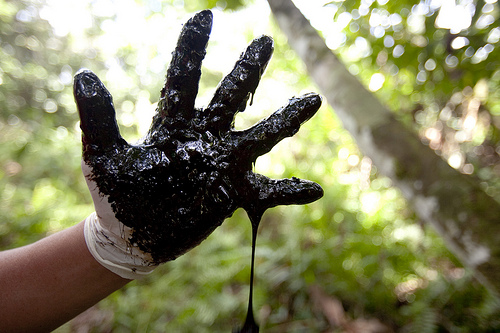 A hand covered in crude contaminates from an open toxic pool in the the Ecuadorean Amazon rainforest near Lago Agrio. It was abandoned by Texaco (now Chevron) after oil drilling operations ended in 1990 and was never remediated. View more pics of Chevron’s toxic legacy in the Ecuadorean Amazon.
A hand covered in crude contaminates from an open toxic pool in the the Ecuadorean Amazon rainforest near Lago Agrio. It was abandoned by Texaco (now Chevron) after oil drilling operations ended in 1990 and was never remediated. View more pics of Chevron’s toxic legacy in the Ecuadorean Amazon.
A few weeks ago, the British government granted Chevron the first deepwater drilling permit it has approved since the BP oil spill disaster in the Gulf of Mexico began back in April.
At virtually the same time — and with little to no fanfare — Chevron finished drilling the first deepwater oil well to be completed in North America since the tragedy in the Gulf started. Some 260 miles northeast of Newfoundland, Chevron’s well is the deepest ever drilled off of Canada’s coasts.
Now we’ve got news that Chevron will spend $7.5 billion on one of the largest deepwater drilling projects in US history. The Houston Chronicle describes it as “a massive floating city about 280 miles southwest of New Orleans.”
Chevron is leading the charge to recklessly exploit the world’s dwindling oil supplies in the post-Gulf oil spill world, but the company prefers to keep that fact quiet. Why? It’s one of those pesky facts that would spoil Chevron’s efforts to recast itself as a responsible, environmentally conscious oil company (despite the obvious fact that “environmentally conscious oil company” is an oxymoron that would require mass-cognitive dissonance to take hold in the public consciousness).
As part of its easy-to-spoof PR efforts, Chevron likes to highlight its projects that don’t actually involve enormous risks to sensitive ecosystems or contribute to global warming. One of those is the Chevron Lucerne Valley Solar Project, which will produce up to 45 megawatts of electricity, enough to power 13,500 – 33,750 homes. There’s definitely a certain poetic justice in Chevron’s dirty oil money being used to help bring more clean, green solar energy into the mix. But don’t go changing your opinion of the company just yet.
Chevron has no intention of changing its core business from dirty fossil fuels to clean renewable energy. That’s just window dressing, meant to mask the supremely dirty business going on inside the shop. In fact, between January 2009 and June 2010, Chevron spent over $28 million on lobbying and PAC contributions to federal candidates in order to protect its oil business, according to the Center for American Progress. The positive benefits of the Chevron Lucerne Valley Solar Project will easily be negated by Chevron continuing its dirty business as usual.
This isn’t the first time Chevron used a solar project as a means of greenwashing its otherwise dirty oil business. We posted about Chevron’s Project Brightfield earlier this year, a solar project the company will use to power its Kern River Heavy Oil Extraction Facility, once again defeating the purpose of green energy by charging full steam ahead with its dirty oil business. See a pattern here?
While all new solar capacity added to the national mix is undoubtedly a good thing, Chevron is plowing millions of dollars into efforts to protect its fossil fuels business, and the company’s own CEO has admitted that he hopes it will take generations to phase fossil fuels out altogether. Meanwhile, the company is aggressively pursuing unprecedented deepwater drilling operations that imperil precious ecosystems and wildlife.
Until Chevron stops working to keep us hooked on the dirty stuff for as long as possible in its blind quest for profits, it cannot credibly claim to be responsible or environmentally conscious. In other words, the company will continue to be ripe for the punking. Download our spoof Chevron ads and get to punking today by putting them up in your town!